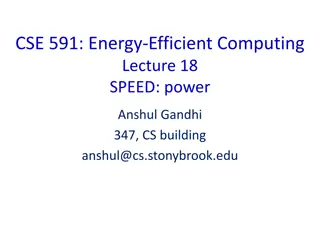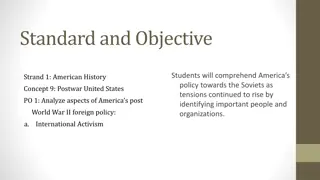America as a World Power - Chapter 7 Summary
America transitioned from isolationism to becoming a world power by gaining territories like Hawaii, engaging in trade with Japan and China, and implementing the Open Door Policy in China. The end of isolationism led to imperialism, with the acquisition of Alaska, Hawaii, and expanding trade interests in the Pacific. The forced annexation of Hawaii and diplomatic negotiations in China and Japan marked key shifts in America's foreign policy strategy.
Download Presentation

Please find below an Image/Link to download the presentation.
The content on the website is provided AS IS for your information and personal use only. It may not be sold, licensed, or shared on other websites without obtaining consent from the author.If you encounter any issues during the download, it is possible that the publisher has removed the file from their server.
You are allowed to download the files provided on this website for personal or commercial use, subject to the condition that they are used lawfully. All files are the property of their respective owners.
The content on the website is provided AS IS for your information and personal use only. It may not be sold, licensed, or shared on other websites without obtaining consent from the author.
E N D
Presentation Transcript
America as a World Power Chapter 7 p. 195
7.1 Gains Territories Main Ideas: US ended its policy of isolationism-belief that US should avoid interfering with other countries . Hawaii became a US territory in 1898. US sought trade with Japan and China Key Terms & People: imperialism, isolationism, William Seward, Liliuokalani, Spheres of influence, Open Door Policy, Boxer Rebellion
End of Isolationism (avoiding foreign involvement) Shipping routes all over the world were protected by Navies of many countries which led to imperialism- building an empire by conquering other nations. America expanded to keep economy strong and built a strong Navy to protect the interest of the US. Sec of State, William Seward arranged purchase of Alaska from Russia-known as Seward s Folly (joke) since many thought Alaska was a frozen wasteland. Alaska became a source of valuable resources-fur, timber, minerals, and even gold. US also purchased Midway-island half-way between Hawaii and Japan; also purchased half of Samoa. Map p. 199
Hawaii & Queen Liliuokalani US missionaries and sugarcane farmers visited the islands. Many purchased shipyards to export sugar. Bayonet Constitution signed at gunpoint by Hawaiian king granted more power to planters. King died later and Queen took over. Queen Liliuokalani attempted to return power to monarchy but planters revolted. American planters took over and formed new government. Annexed to the US in 1898 as the 50th state.
Trade with Japan and China US desired to trade for economic interest. Japan was isolated so US attempted to befriend Japan with no success. Japan signed trade agreement when 7 warships appeared and US interests were explained. Russia invaded China. Japan attacked Russians in China. US negotiated peace between Japan and Russian War after Japan had taken control over Korea and a Chinese port. Germany, Great Britain, France, Japan and Russia took advantage of China s weakness and split areas of the country.. Spheres of influence-areas where foreign nations controlled resources.
Open Door Policy ODP-policy states all nations should have equal access to China-produced by US Sec of State John Hay-made US intentions clear to others Boxer Rebellion Chinese citizens resented foreign involvement and started the Boxer Rebellion (due to closed fist symbols) Boxers protested in Beijing killed foreigners over 2 months but were eventually defeated. China paid $333 million afterwards ($25 mil to US) Open Door Policy remained in effect until WW2
7.2 Spanish American War Main Idea: US went to war with Spain. US gained territories in the Caribbean and Pacific. Key Terms & People: yellow journalism, Teller Amendment, Emilio Aguinaldo, Anti-Imperialist League, Platt Amendment
Spanish American War Newspapers printed exaggerated stories about Spain s brutal control over Cuba (map). Yellow journalism is when news reports are exaggerated. Joseph Pulitzer published plenty of stories to support US in Cuba. US sent USS Maine to Havana Harbor (Cuba) to protect American interests The ship unexpectedly exploded and sank killing 266 US sailors. US immediately blamed Spain (no proof). Congress approved war to remove Spain from Cuba Teller Amendment-stated US had no interest in controlling Cuba -just protecting US interests Remember the Maine was their battle cry
Philippines As Americans were focused on Cuba, the US Navy freed the Philippine islands (map) from Spanish rule Commodore George Dewey sailed into Manila Bay & destroyed 10 Spanish ships Emilio Aguinaldo, a Filipino rebel helped the US Navy take control of Philippines. However, US only annexed the islands which did not grant them US freedoms so Aguinaldo turned on US
Rough Riders in the Caribbean Cuba is tropical and hot Theodore Roosevelt led a volunteer group of men called the Rough Riders to fight Spain in Cuba Major victory: San Juan Hill (Cuban Capital) US destroyed all of Spain s battleships Spain s leader, Santiago surrendered Cuba became an independent country (still is today) US also captured Puerto Rico & Guam from Spain with little effort
US Territories Gained Philippines, Puerto Rico, and Guam became US territories Anti-Imperialist League was a group that opposed territorial expansion-accused US of creating an empire Platt Amendment limited Cuba s right to make treaties and allowed the US to intervene in Cuban affairs - Cubans reluctantly agreed US stayed involved in Cuban affairs until the 50 s and recently renewed a business relationship with Cuba (communist country)
7.3 US & Latin America Main Idea: US built the Panama Canal. T Roosevelt changed US policy toward Latin America. Presidents Taft and Wilson promoted US interests in Latin America. Key Terms & People: Panama Canal, Roosevelt Corollary, dollar diplomacy, Mexican Revolution, John J Pershing, Francisco Pancho Villa Where is Latin America? Central & South America EX: Equador, Belize, Costa Rica, El Salvador, Guatemala, Honduras, Mexico, Nicaragua, Panama, Dominican Republic, Cuba, Puerto Rico... (33 countries)
The Panama Canal Canal that separates an isthmus in Central America between Panama and Columbia (map) Goals: link the Pacific to the Atlantic Ocean; decreasing travel by 8000 miles Columbia would not agree to allow US to build canal so Roosevelt supported Panama in a revolt against Columbia-freed Panama from Columbian rule-then Panama agreed to US building canal Many workers died of disease and accidents constructing the canal US paid Panama $10M + $250,000 annually for 99 years for a 10 mile wide strip of land (open 1914) Was it worth it? Picture p. 212
Latin America Policy (laws/rules) Speak softly but carry a big stick. -T Roosevelt What does that mean? US growing stronger with major influence in the world President Monroe wrote the Monroe Doctrine-warned European nations not to interfere with W hemisphere Roosevelt Corollary-an addition to the Monroe Doctrine that warned in cases of wrongdoing by Latin American countries-first international policing power-new role in W hemisphere for US Analyze political cartoon p. 213
Dollar Diplomacy DD is influencing governments through economic, not military, intervention -written by President Taft Substituting dollars for bullets What does that mean? President Wilson rejected DD-he believed US had a moral obligation to promote democracy & was willing to use military force to protect US interests Mexican Revolution -citizens revolted against dictator US had invested in Mexican land, mining, oil, and railways and were concerned Germany was sending weapons to rebels in Mexico. John J Pershing & soldiers went to Mexico to capture rebel leader Pancho but failed. Many Mexicans fled due to the years of violence
Foreign Policy US Presidents have opinions on how to interact with other countries ... Washington s Farewell-states US will NOT get involved in European issues Chart p. 215 Monroe Doctrine-states US will defend interests in W hemisphere away from Europeans Roosevelt Corollary-states US will watch and control W hemisphere like police Taft s Dollar Diplomacy-states US will use the dollar to help interests in Latin America Wilson s Democracy-states US will promote and protect democracy in the W hemisphere
TEST TIME Review p. 219-220 You can read the chapters at home Study Vocab and Main Ideas Practice Quizlet





























